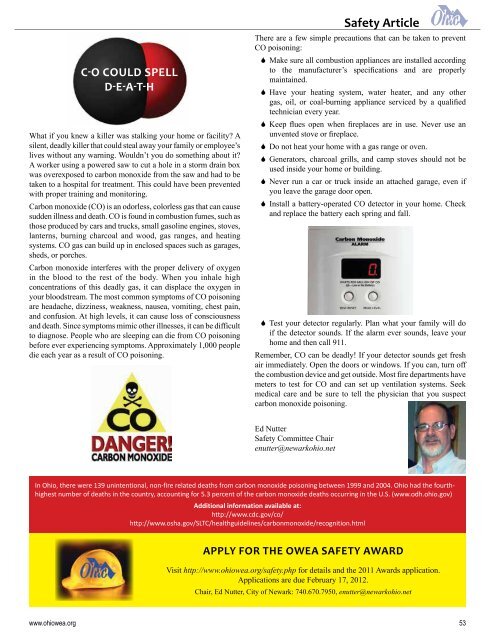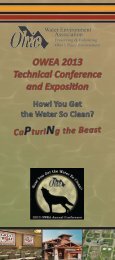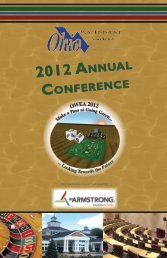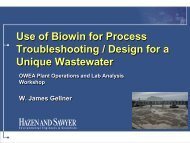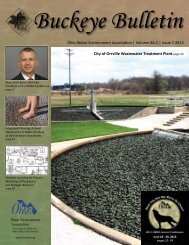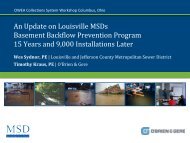Ohio Water Environment Association | Volume 85:1 | Issue 1 2012 ...
Ohio Water Environment Association | Volume 85:1 | Issue 1 2012 ...
Ohio Water Environment Association | Volume 85:1 | Issue 1 2012 ...
Create successful ePaper yourself
Turn your PDF publications into a flip-book with our unique Google optimized e-Paper software.
C-O Could Spell<br />
D-E-A-T-H<br />
What if you knew a killer was stalking your home or facility A<br />
silent, deadly killer that could steal away your family or employee’s<br />
lives without any warning. Wouldn’t you do something about it<br />
A worker using a powered saw to cut a hole in a storm drain box<br />
was overexposed to carbon monoxide from the saw and had to be<br />
taken to a hospital for treatment. This could have been prevented<br />
with proper training and monitoring.<br />
Carbon monoxide (CO) is an odorless, colorless gas that can cause<br />
sudden illness and death. CO is found in combustion fumes, such as<br />
those produced by cars and trucks, small gasoline engines, stoves,<br />
lanterns, burning charcoal and wood, gas ranges, and heating<br />
systems. CO gas can build up in enclosed spaces such as garages,<br />
sheds, or porches.<br />
Carbon monoxide interferes with the proper delivery of oxygen<br />
in the blood to the rest of the body. When you inhale high<br />
concentrations of this deadly gas, it can displace the oxygen in<br />
your bloodstream. The most common symptoms of CO poisoning<br />
are headache, dizziness, weakness, nausea, vomiting, chest pain,<br />
and confusion. At high levels, it can cause loss of consciousness<br />
and death. Since symptoms mimic other illnesses, it can be difficult<br />
to diagnose. People who are sleeping can die from CO poisoning<br />
before ever experiencing symptoms. Approximately 1,000 people<br />
die each year as a result of CO poisoning.<br />
Safety Article<br />
There are a few simple precautions that can be taken to prevent<br />
CO poisoning:<br />
66<br />
Make sure all combustion appliances are installed according<br />
to the manufacturer’s specifications and are properly<br />
maintained.<br />
66<br />
Have your heating system, water heater, and any other<br />
gas, oil, or coal-burning appliance serviced by a qualified<br />
technician every year.<br />
66<br />
Keep flues open when fireplaces are in use. Never use an<br />
unvented stove or fireplace.<br />
66<br />
Do not heat your home with a gas range or oven.<br />
66<br />
Generators, charcoal grills, and camp stoves should not be<br />
used inside your home or building.<br />
66<br />
Never run a car or truck inside an attached garage, even if<br />
you leave the garage door open.<br />
66<br />
Install a battery-operated CO detector in your home. Check<br />
and replace the battery each spring and fall.<br />
66<br />
Test your detector regularly. Plan what your family will do<br />
if the detector sounds. If the alarm ever sounds, leave your<br />
home and then call 911.<br />
Remember, CO can be deadly! If your detector sounds get fresh<br />
air immediately. Open the doors or windows. If you can, turn off<br />
the combustion device and get outside. Most fire departments have<br />
meters to test for CO and can set up ventilation systems. Seek<br />
medical care and be sure to tell the physician that you suspect<br />
carbon monoxide poisoning.<br />
Ed Nutter<br />
Safety Committee Chair<br />
enutter@newarkohio.net<br />
In <strong>Ohio</strong>, there were 139 unintentional, non-fire related deaths from carbon monoxide poisoning between 1999 and 2004. <strong>Ohio</strong> had the fourthhighest<br />
number of deaths in the country, accounting for 5.3 percent of the carbon monoxide deaths occurring in the U.S. (www.odh.ohio.gov)<br />
Additional information available at:<br />
http://www.cdc.gov/co/<br />
http://www.osha.gov/SLTC/healthguidelines/carbonmonoxide/recognition.html<br />
Apply for the OWEA Safety Award<br />
Visit http://www.ohiowea.org/safety.php for details and the 2011 Awards application.<br />
Applications are due February 17, <strong>2012</strong>.<br />
Chair, Ed Nutter, City of Newark: 740.670.7950, enutter@newarkohio.net<br />
www.ohiowea.org 53


